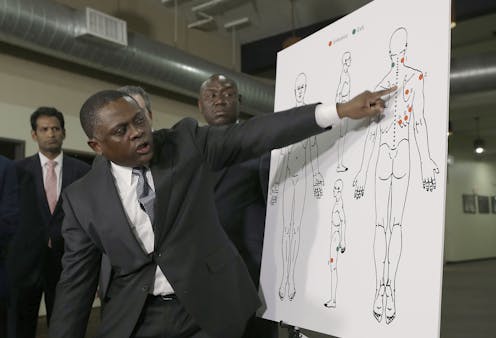When police use force: 3 essential reads
- Written by Danielle Douez, Associate Editor, Politics + Society

Following the fatal police shooting[1] of 22-year-old Stephon Clark, an unarmed black man in Sacramento, protesters have gathered to express anger over his death.
At issue is what is called police “use of force.” That’s when police exert physical force to make an individual comply with their orders. Each police department has policies for when use of force is appropriate. Protesters and Clark’s family members argue shooting at Clark 20 times was excessive. The California Department of Justice is investigating[2] whether the officers involved breached any policies and whether policies need to be changed.
We’ve turned to our archives for a look at what experts say drives how and when police use force, and how it ties in to issues of race and gender.
1. Unconscious bias
One leading theory that is used to explain police behavior is what psychologists call implicit bias. The idea is that police officers, like all humans, have biases – negative attitudes and beliefs toward members of a social group.
As psychology professors Kate Ratliff[3] and Colin Smith[4] at the University of Florida explain, what makes these biases hard to address is that they exist outside of a person’s conscious awareness and control[5]. These experts explain the methods scientists are developing to measure implicit bias, such as the Implicit Association Test.
Data from such tests have revealed, for example, that “Pro-white implicit biases are pervasive. Data from millions of visitors to the Project Implicit website reveal that, while about 70 percent of white participants report having no preference between black and white people, nearly the same number show some degree of pro-white preference on the IAT.”
Psychologists and social scientists are only beginning to understand how to apply this science to change behavior.
2. Machismo
Another issue people often point to is machismo, which law professor Frank Rudy Cooper[6] of Suffolk University describes as “a gendered, aggressive outlook” that is embedded in police training and culture.
One of the essential components of this outlook, Cooper writes, is zero tolerance for disrespect. This can even apply to female officers. When police officers feel disrespected, their natural response is to punish and often escalate a situation[7].
“Such escalation is commonly known as ‘contempt of cop.’ Being found in contempt of court is a punishment for disobeying a judge. ‘Contempt of cop’ occurs when an officer punishes you for failing to comply with her request.”
3. Lack of police-community trust
Historically bad relations between police and communities of color may also be a contributor to the ongoing violence. Police departments across the U.S. are seeking ways to train officers on improving trust and citizen cooperation[8].
Megan Price[9], a professor at George Mason University, is also director of a program called Insight Conflict Resolution. A new strategy called Insight Policing, she writes, is a “community-oriented, problem-solving policing practice designed to help officers take control of situations with the public before conflict escalates.” Pilot programs have been tested in Memphis, Tennessee and Lowell, Massachusetts.
The program teaches officers to defuse citizens’ behavior that is threatening or intended to cause conflict. Price writes,“ Eighty percent of officers trained agreed that Insight Policing enhanced their ability to defuse the feelings of threat citizens have about their encounters with police officers.”
References
- ^ fatal police shooting (www.nytimes.com)
- ^ is investigating (www.npr.org)
- ^ Kate Ratliff (theconversation.com)
- ^ Colin Smith (theconversation.com)
- ^ hard to address is that they exist outside of a person’s conscious awareness and control (theconversation.com)
- ^ Frank Rudy Cooper (theconversation.com)
- ^ their natural response is to punish and often escalate a situation (theconversation.com)
- ^ train officers on improving trust and citizen cooperation (theconversation.com)
- ^ Megan Price (theconversation.com)
Authors: Danielle Douez, Associate Editor, Politics + Society
Read more http://theconversation.com/when-police-use-force-3-essential-reads-94280


